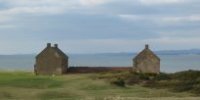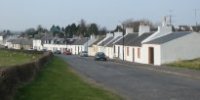[first
published in Ayrshire Notes 23, Ayr (2002)]
Sawney Bean raised his ugly head in the last issue
of Ayrshire Notes, in a manner which scarcely does credit
to the editors or the author concerned. The reaction of any serious
historian (particularly a local historian in Ayrshire) to the Sawney
Bean myth should be polite incredulity at least, and outright denunciation
at best. Several historians and antiquarians between the late 19th
Century and the present day have debunked the story. However, for
every sober refutation to appear in print there continue to appear
hundreds of credulous regurgitations of the original tale. Irritating
though it is to have to expend time and ink on such tabloid history,
I am grateful to the editors for this opportunity to review what
is known about the Sawney Bean myth (note 1).
Sawney Bean is reputed to have been a mass–murderer and cannibal,
who lived with his family in a cave near Ballantrae, on what is
now the Ayrshire coast, during the reign of James VI, or during
the reign of James I (of Scotland). Versions of the tale proliferated
in the 19th Century in books and magazines. Newspaper editors and
journalists with column inches to fill in the silly season, and
radio and television producers with spare airtime for airheads have
maintained and increased Sawney’s notoriety over the last 100 years.
And given the success of recent porridge westerns it cannot be long
before the cameras begin to roll on a Hollywood blockbuster. Braised
Heart, perhaps.
In the 1970s a rural myth somehow spread beyond Carrick that a cave
at Balcreuchan Port, near Ballantrae, was Sawney Bean’s abode (note
2). An increasing number of sightseers made their way down the
precarious route to the cave and, fearing an accident, the local
authority (the Kyle and Carrick District Council) improved the pathway
in 1978. This had the unfortunate effect of promoting the site,
which has since been noted in tourist literature, and recently the
Ordnance Survey has marked the location of the cave on its Landranger
maps. It is worth pointing out here that, far from bestowing historical
legitimacy on a site, recognition of it by the Ordnance Survey very
often confers the opposite. The Survey’s carelessness with respect
to marking sites like this is well–known, at least to the many people
who have attempted to find the site of (what the Survey calls) ‘Prince
Charlie’s Cave’ on the slopes of Ben Alder (there wasn’t a cave,
and it wasn’t the Bonnie Prince who resided there). To be fair to
the Ordnance Survey, it merely records an existing use of a site
in order to sell maps. In this respect, it is no worse and no better
than anyone else who has boarded the bandwagon of Caledonian mythology.
Doubts have been expressed about the story from at least the late
19th Century and by the early part of the 20th Century the origins
of the story were unravelling in antiquarian journals, for example
in the periodical Scottish Notes and Queries (note
3). In the 1930s the legal historian William Roughead wanted
to include the case of Sawney Bean in his Notable British Trials
series. Roughead reported that he had ‘sought diligently for Sawney
in the official records of the time in contemporary journals, diaries
and memoirs, in the pages of gossiping annalists and of grave historians’,
but failed to find ‘either in print or in manuscript the slightest
mention of him’, and concluded that Bean was a completely fictional
character (note 4).
Roughead found (as others before him had) that the story probably
dates from the early 18th Century, becoming widely known through
a book by a Captain Charles Johnson entitled A General and True
History of the Lives and Sections of the Most Famous Highwaymen,
Murderers, Street–Robbers, &c., published in London in
1734 and Birmingham in 1742. Although Johnson stated that his account
was ‘as well attested as any historical fact can be’, he did not
record any source for the story. Roughead suggested that Johnson’s
source was a similar work by Alexander Smith published in London
in 1719 entitled A Compleat History of the Lives and Robberies
of the Most Notorious Highwaymen.
Smith, in turn, almost certainly lifted the material from 18th Century
chapbooks and broadsheets. These were early forms of printed books,
to some extent precursors of the tabloid newspaper, sold primarily
by pedlars, especially at fairs and public executions. The content
of chapbooks and broadsheets frequently concerned executions, murders,
other major crimes and strange occurrences: cheap thrills. They
were replaced as popular reading matter by the ‘penny dreadfuls’
of Victorian times. Four such chapbooks, recounting the Bean story,
survive in the Lauriston Castle Collection of the National Library
of Scotland (note 5). Roughead ingeniously
suggested that these or their precursor might have been written
by Daniel Defoe.
Many of the tales from these chapbooks and broadsheets were collected
and published in the Newgate Calendar, which first appeared
in the 1770s, taking its name from the prison of Newgate in London,
the scene of many public executions. Some of the stories in the
Newgate Calendar were based on real cases, others (such
as the story of Sawney Bean) were almost certainly fictional. The
many editions and reprints of the Calendar in the 19th
and 20th Centuries have assured Sawney Bean an international notoriety.
Adherents of the story point to the amount of detail in the published
versions as supporting evidence and cling to the hope that historical
records may yet provide validation. However, the dating of the story
to the late 16th Century (or earlier) means that there are relatively
few contemporary sources of information available to the researcher,
and most have already been searched. Indeed, the mass of supporting
detail, in the absence of historical record, casts more doubt on
the story.
For example, the story goes into some detail about Bean’s origins
in East Lothian. Why say he was born ‘about 8 or 9 miles eastward
of the city of Edinburgh’ instead of mentioning the actual place?
Probably because the chapbooks and later versions of the story were
aimed at an English audience, and Edinburgh was sufficiently well–known
in England, whereas Tranent or Macmerry or wherever was not. His
parents ‘worked at hedging and ditching’ but it is unlikely that
anyone specialised at those occupations in the Scotland of the 15th
and 16th Centuries. The obvious source for all of these details
would be an old parish register of births, but the earliest registers
of births for East Lothian parishes date from the 1590s: too late
by several decades to record Mr Bean and his parents.
The Bean family’s 25–year spree of robbery and cannibalism accounted
for over 1000 victims, and (according to the tale) caused a ‘general
outcry in the country round about’ and ‘the whole country was almost
depopulated’. One might presume, then, that some mention of the
outcry would be found in family papers, correspondence and memoirs
of the period. Nothing of the sort has ever surfaced and William
Roughead, one suspects, left few stones unturned on his search for
a good, but valid, story. No account of Bean appears in Pitcairn’s
Criminal Trials in Scotland, 1494–1624. Neither is there
any record of the trials of the travellers and innkeepers who were,
according to the story, wrongfully hanged for Bean’s murders.
Other details in the story look odd or anachronistic. A survivor
of an attack by Bean is taken to Glasgow to see the Provost. Why
Glasgow, when the nearest royal burghs were Ayr and Irvine? Why
a provost, when the appropriate jurisdiction would have been that
of the Sheriff of Ayr? The king then sets out with a body of about
400 men and bloodhounds. James VI is one of the most researched
Scots monarchs, but no historian has reported finding mention of
such an expedition in records of the exchequer, household and other
crown records.
After capture, Bean and his family were reputedly committed to the
tolbooth in Edinburgh, which at the time was probably a single tower,
quite ruinous, and certainly incapable of housing several dozen
prisoners.(note 6) The warding and liberation
books of Edinburgh tolbooth begin in 1657. How inconvenient! Then
the Bean family is executed at Leith: the men having their limbs
amputated and the women burnt at the stake. Barbarous executions
of this sort were not as common in Scotland as is often supposed
– they were generally reserved for traitors or regicides, and they
were so unusual as to be well attested contemporaneously. Executions
were normally staged by burghs and the costs involved are usually
scrupulously recorded in burgh minute books and accounts, but no
one has ever reported any such costly execution.
Perhaps there is no smoke without fire. Is it possible that the
story is grossly distorted folklore relating to some local murder
case, for which no historical evidence survives? The short answer
is: we’ll never know. On the other hand, there is sufficient evidence
from what we know of the literary origins of the story to suppose
that it is not even genuine folklore (if such a thing exists), but
the invention of 18th Century sensationalists. The story cannot
be traced beyond the 18th Century equivalent of the Sunday Sport,
so is it worth pursuing at all? I can think of no sound reason
for doing so other than gratuitous and morbid titillation. What
is most reprehensible about all this is that the myth is popularized
as part of a despicable conspiracy of the heritage industry, tourist
agencies and local authorities to turn parts of Scotland into little
more than gruesome theme parks. If peddling the Sawney Bean story
attracts tourists to Carrick, surely they are the wrong kind of
tourists.
1 For a lengthier debunking see Ronald Holmes,
The Legend of Sawney Bean, London 1975. As the dust jacket
says: ‘The author sets out on the three–hundred year old trail of
this monster who, together with his family, killed and ate over
1000 people in 25 years; and as the clues are examined it soon becomes
evident that the real monsters are black shadows from the primitive
past of the human mind.’
2 S R Crockett, in The Grey Man, (1896) was the first to
locate Bean’s cave at or near Bennane Head. [Holmes, op cit, p.26–27].
In the early 1970s Bennane Cave was ‘partly walled–up and occupied
by a hermit’ [James Lawson and Judith Lawson, Geology Explained
around Glasgow and South–West Scotland, including Arran, Newton
Abbot, 1976, p.116]
3 Scottish Notes and Queries, 2nd series, Vol 8, (1906–07),
pp 101 and 129.
4 William Roughead, 'The Monster of Ballantrae' in Juridical
Review, 45, 1933. Roughead did, however, include Bean among
the nine cases he covered in his Rogues Walk Here, London,
1934.
5 The History of Sawney Beane and His Family; Robbers and Murderers,
undated, 18th Century. Printed in London. It contains six illustrations.
NLS reference LC 2737, no.7; The Life of Sawney Beane, the Man Eater,
undated, 18th Century. Printed in Hull. NLS reference LC 2746.E,
no.19; another copy of the above. NLS reference LC 2746.E, no.20;
Horrid Life of Sawney Beane, undated, 18th Century. Printed
in Carlisle. NLS reference LC 2901, no.1.
6 Royal Commission on the Ancient and Historical Monuments of Scotland,
Tolbooths and Town–houses: civic architecture in Scotland to
1833, Edinburgh 1996.
|




